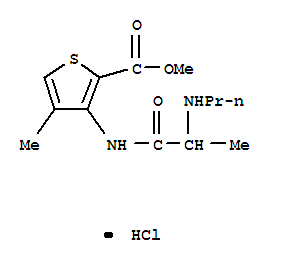
CasNo: 23964-57-0
Molecular Formula: C13H20N2O3S.HCl
Appearance: white powder
|
Chemical Properties |
White or almost white, crystalline powder. |
|
Originator |
Ultracain,Hoechst,W. Germany,1976 |
|
Uses |
Articaine is an amide local anesthetic most commonly used in dentistry. Articaine hydrochloride is the hydrochloride Salt of Articaine, a amide based short-acting local anesthetic use for regional anaesthesia in day-case settings such arthroscopy, hand , food surgery and in dentistry. |
|
Brand name |
Septanest (Cilag-Chemie, Switzerland); Septocaine (Cilag-Chemie, Switzerland); Ultracaine (Hoechst AG, Germany). |
|
Therapeutic Function |
Local anesthetic |
|
Contact allergens |
This local amide-type anesthetic is seldom reported as allergenic even in patients sensitized to other amidetype molecules like lidocaine, prilocaine, mepivacaine, or bupivacaine. |
|
Biochem/physiol Actions |
Articaine hydrochloride helps to alleviate pain and blocks transmission of the pain signal. Articaine is an amide local anesthetic widely used in dentistry. Articaine acts by inhibition of nerve impulse conduction by blockade of sodium channels. |
|
Mode of action |
Articaine hydrochloride reversibly blocks nerve impulse conduction by binding to specific membrane sodium ion channels thereby interfering with the electrical excitation in the nerve, slowing the propagation of the nerve impulse and reducing the rate of rise of the action potential. This results in a loss of sensation at the injection site. Articaine hydrochloride is used for relief of pain in minor operations, usually in combination with the vasoconstrictor epinephrine. |
InChI:InChI=1/C13H20N2O3S.ClH/c1-5-6-14-9(3)12(16)15-10-8(2)7-19-11(10)13(17)18-4;/h7,9,14H,5-6H2,1-4H3,(H,15,16);1H
… and efficacy of articaine HCl (4% with epinephrine 1:100,000) to that of lidocaine HCl (2% … Methods: Fifty subjects under the age of 13 years were treated in the articaine group and 20 …
The epinephrine concentration (1:100,000 or 1:200,000) and local anesthetic solutions used (2% lidocaine or 4% articaine) influenced hemodynamic parameters without perceptible clinical changes in healthy patients undergoing lower third molar removal.